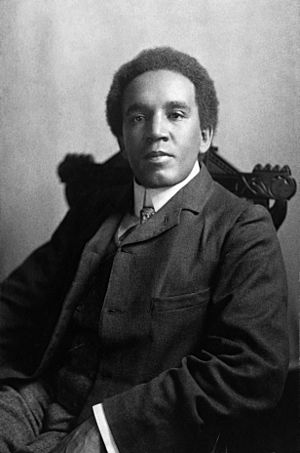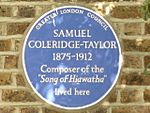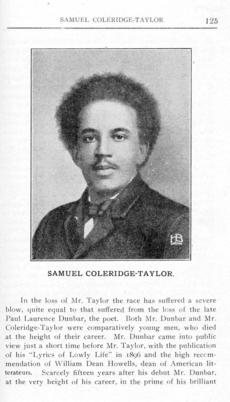Samuel Coleridge-Taylor facts for kids
Quick facts for kids
Samuel Coleridge-Taylor
|
|
|---|---|

Samuel Coleridge-Taylor in 1905
|
|
| Born |
Samuel Coleridge Taylor
15 August 1875 Holborn, London, England
|
| Died | 1 September 1912 (aged 37) Croydon, Surrey, England
|
| Occupation | Classical composer and musician |
| Spouse(s) | Jessie Walmisley |
| Children | Hiawatha and Avril Coleridge-Taylor |
Samuel Coleridge-Taylor (born August 15, 1875 – died September 1, 1912) was a famous British composer and conductor.
He was of mixed-race heritage. His music was so popular that musicians in New York called him the "African Mahler." This happened when he visited the United States three times in the early 1900s. He was especially known for his three long musical pieces, called cantatas. These were based on the epic poem The Song of Hiawatha by American poet Henry Wadsworth Longfellow. Coleridge-Taylor first performed a part of this work in 1898, when he was just 22 years old.
He married Jessie Walmisley, a British woman. Both of their children became musicians. Their son, Hiawatha, arranged his father's music for different shows. Their daughter, Avril Coleridge-Taylor, became a composer and conductor herself.
Contents
Early Life and Music Training
Samuel Coleridge-Taylor was born in Holborn, London. His mother, Alice Hare Martin, was English. His father, Daniel Peter Hughes Taylor, was a Krio man from Sierra Leone. His father was studying medicine in London. He returned to Africa before Samuel was born and did not know Alice was pregnant.
Alice and her son lived with her father, Benjamin Holmans. Benjamin was a skilled farrier, someone who cares for horses' hooves. The family called Samuel "Coleridge." In 1887, Alice married George Evans, a railway worker. They lived in Croydon.
Many people in Samuel's mother's family were musicians. His grandfather played the violin and taught Samuel from a young age. Samuel's musical talent was clear very early on. His family helped him study at the Royal College of Music when he was 15. He started by playing the violin but then focused on composing music. His teacher was Charles Villiers Stanford.
After finishing his studies, he became a professional musician. He taught at the Crystal Palace School of Music. He also started leading the orchestra at the Croydon Conservatoire. He later began using the name "Samuel Coleridge-Taylor" with a hyphen. Some say this was due to a printing mistake.
Marriage and Family
In 1899, Coleridge-Taylor married Jessie Walmisley. They had met while studying at the Royal College of Music. Jessie was six years older than him. Her parents were not happy about the marriage because Samuel was of mixed-race background. However, they eventually agreed and attended the wedding.
Samuel and Jessie had two children. Their son was named Hiawatha (born 1900) after the Native American hero in the famous poem. Their daughter was Gwendolen Avril (born 1903). Both children became musicians. Hiawatha arranged his father's musical works. Gwendolen started composing music early and became a conductor and composer. She used the professional name Avril Coleridge-Taylor.
Music Career and Success
By 1896, Coleridge-Taylor was already becoming known as a composer. Famous composer Edward Elgar helped him by recommending him to the Three Choirs Festival. Coleridge-Taylor's "Ballade in A minor" was first performed there. A very important music editor, August Jaeger, also supported him. Jaeger told Elgar that Samuel was "a genius."
Coleridge-Taylor became very popular because of his piece Hiawatha's Wedding Feast. This work was first performed in 1898 and was a huge success. Because of its popularity, he visited the United States three times: in 1904, 1906, and 1910. In the U.S., he became more interested in his father's African heritage.
He attended the 1900 First Pan-African Conference in London. There, he met important Americans like poet Paul Laurence Dunbar and scholar W.E.B. Du Bois. Samuel's father's family were descendants of African-American slaves. These slaves were freed by the British after the American War of Independence. Many of them settled in Nova Scotia or Sierra Leone.
In 1904, during his first U.S. tour, President Theodore Roosevelt welcomed Coleridge-Taylor at the White House. This was a rare honor for a Black man at that time. His music was played widely, and he had strong support from African Americans. Coleridge-Taylor wanted to use traditional African music in his classical compositions. He felt this was similar to how Johannes Brahms used Hungarian music and Antonín Dvořák used Bohemian music.
He met the African-American poet Paul Laurence Dunbar in London. Taylor then set some of Dunbar's poems to music. They even gave a joint performance in London. Other Black artists encouraged Coleridge-Taylor to explore his Sierra Leonean roots and African music. He was also invited to judge music festivals. He was a shy person but was a very good conductor.
Composers often sold the full rights to their music to get money quickly. This meant they did not earn money from future sales or performances. Hiawatha's Wedding Feast sold hundreds of thousands of copies. But Coleridge-Taylor had sold the rights for only 15 guineas. So, he did not directly benefit from its huge success. He later learned to keep his rights for other works. However, he often struggled with money throughout his life.
Death and Tributes
Coleridge-Taylor was only 37 years old when he died from pneumonia. His death is often linked to the stress of his money problems. He was buried in Bandon Hill Cemetery in Wallington, Surrey.
- His headstone has four bars of music from his most famous work, Hiawatha. It also includes a tribute from his friend, the poet Alfred Noyes.
- King George V gave Jessie Coleridge-Taylor, Samuel's young widow, an annual pension of £100. This showed how highly the composer was thought of.
- In 1912, a memorial concert was held at the Royal Albert Hall. It raised over £1400 for his family.
- After his death, musicians realized that Coleridge-Taylor and his family had not received money from The Song of Hiawatha. This was one of the most popular works of the past 50 years. His situation helped lead to the creation of the Performing Right Society. This group helps musicians earn money from their music being performed, published, and distributed.
Coleridge-Taylor's music remained popular. Conductor Malcolm Sargent especially supported his work. From 1928 to 1939, Sargent conducted a large ballet version of The Song of Hiawatha at the Royal Albert Hall. It featured 600 to 800 singers and 200 dancers.
Lasting Impact
Coleridge-Taylor's biggest success was his cantata Hiawatha's Wedding Feast. Choral groups in England performed it often during and after his lifetime. Its popularity was almost as great as famous works like Handel's Messiah and Mendelssohn's Elijah. The composer later wrote two more cantatas about Hiawatha: The Death of Minnehaha and Hiawatha's Departure. All three, plus an Overture, were published together as The Song of Hiawatha, Op. 30. The popular Hiawatha shows at the Royal Albert Hall continued until 1939. Hiawatha's Wedding Feast is still sometimes performed today.
Coleridge-Taylor also wrote chamber music, anthems, and the African Dances for violin. His Petite Suite de Concert is still played regularly. He even set a poem by his namesake, Samuel Taylor Coleridge, called "The Legend of Kubla Khan."
African Americans greatly admired Coleridge-Taylor. In 1901, a 200-voice African-American choir was started in Washington, D.C., named the Samuel Coleridge-Taylor Society. He visited the U.S. three times and was highly praised. In 1910, white orchestra musicians in New York called him "the African Mahler." Public schools in Louisville, Kentucky, and Baltimore, Maryland, were named after him.
Coleridge-Taylor wrote a violin concerto for American violinist Maud Powell. The music parts for the American performance were lost on a ship, not the RMS Titanic as some legends say. The concerto has been recorded by several violinists and orchestras. It was also performed at Harvard University in 1998 to celebrate 100 years since Hiawatha's Wedding Feast was composed.
You can find lists of Coleridge-Taylor's works and recordings through the Samuel Coleridge-Taylor Foundation. There are two blue plaques in his memory in London. A metal statue of him is in Charles Street, Croydon.
A two-hour documentary, Samuel Coleridge Taylor and His Music in America, 1900–1912 (2013), was made about him. It includes performances of his music and details about his important place in music. An animated film, The Samuel Coleridge-Taylor Story (2013), was also made. In 2021, Coleridge-Taylor's Symphony in A minor was performed at the Proms by the Chineke! Orchestra.
Music Published After His Death
In 1999, music editor Patrick Meadows found three important chamber music pieces by Coleridge-Taylor. These had never been widely printed or available. A handwritten version of the Piano Quintet was made earlier by violinist Martin Anthony Burrage. The first modern performance of the Piano Quintet happened on November 7, 2001, in Liverpool.
After getting copies, Patrick Meadows created printed versions of the Nonet, Piano Quintet, and Piano Trio. These works were performed at a music festival in Majorca and were very popular. The Boston-based Coleridge Ensemble had performed some of these works in the early 1990s. This group also made the first recordings of the Nonet, Fantasiestücke, and Six Negro Folksongs in 1998.
In 2006, Meadows finished preparing the first printed edition of Coleridge-Taylor's Symphony in A minor. He also copied the Haytian Dances from a manuscript. This work is for string orchestra, tambourine, and triangle.
Thelma, The Lost Opera
Coleridge-Taylor's only full-length opera, Thelma, was thought to be lost for a long time. In 1995, a book about him said the manuscript had not been found. However, Catherine Carr found the manuscripts of Thelma in the British Library while doing research. She put together the story (libretto) and studied the opera.
Thelma is a story about lies, magic, revenge, and love winning over evil. The composer followed Richard Wagner's style, blending singing and music together smoothly instead of using separate songs. Coleridge-Taylor wrote Thelma between 1907 and 1909. It was also called The Amulet.
The full music score and vocal score are in the composer's own handwriting at the British Library. Patrick Meadows and Lionel Harrison prepared a typed version of the music and story. The composer changed the heroine's name to "Freda" in the scores, but Meadows and Harrison decided to use the original name, Thelma.
Thelma was first performed in Croydon in February 2012. This was 100 years after the composer's death. Surrey Opera performed it, with Jonathan Butcher conducting.
List of Compositions
With Opus Number
- Piano Quintet in G minor, Op. 1 – 1893
- Nonet in F minor for oboe, clarinet, bassoon, horn, violin, viola, cello, contrabass and piano, Op. 2 – 1894
- Suite for Violin and Organ (or piano), Op. 3 (Suite de Piêces)- 1893
- Ballade in D minor, Op. 4 – 1895
- Five Fantasiestücke, Op. 5 – 1896
- Little Songs for Little Folks, Op. 6 – 1898
- Zara's Earrings, Op. 7 – 1895
- Symphony in A minor, Op. 8 – 1896
- Two Romantic Pieces, Op. 9 – 1896
- Quintet in F sharp minor for clarinet and strings, Op. 10 – 1895
- Southern Love Songs, Op. 12 – 1896
- String Quartet in D minor, Op. 13 – 1896 (lost)
- Legend (Concertstück), Op. 14
- Land of the Sun, Op. 15 – 1897
- Three Hiawatha Sketches for violin and piano, Op. 16 – 1897
- African Romances (P. L. Dunbar) Op. 17 – 1897
- Morning and Evening Service in F, Op. 18 – 1899
- Two Moorish Tone-Pictures, Op. 19 – 1897
- Gypsy Suite, Op. 20 – 1898
- Part Songs, Op. 21 – 1898
- Four Characteristic Waltzes, Op. 22 – 1899
- Valse-Caprice, Op. 23 – 1898
- In Memoriam, three rhapsodies for low voice and piano, Op. 24 – 1898
- Dream Lovers, Operatic Romance, Op. 25 – 1898
- The Gitanos, cantata-operetta, Op. 26 – 1898
- Violin Sonata in D minor, Op. 28 – ?1898 (pub. 1917)
- Three Songs, Op. 29 – 1898
- The Song of Hiawatha, Op. 30 ("Overture to The Song of Hiawatha", 1899; "Hiawatha's Wedding Feast", 1898; "The Death of Minnehaha", 1899; "Hiawatha's Departure", 1900)
- Three Humoresques, Op. 31 – 1898
- Ballade in A minor, Op. 33 – 1898
- African Suite, Op. 35 – 1899
- Six Songs, Op. 37
- Three Silhouettes, Op. 38 – 1904
- Romance in G, Op. 39 – 1900
- Solemn Prelude, Op. 40 – 1899
- Scenes From An Everyday Romance, Op. 41 – 1900
- The Soul's Expression, four sonnets, Op. 42 – 1900
- The Blind Girl of Castél-Cuillé, Op. 43
- Idyll, Op. 44 – 1901
- Six American Lyrics, Op. 45 – 1903
- Concert Overture, Toussaint L'Ouverture, Op. 46 – 1901
- Hemo Dance, scherzo, Op. 47(1) – 1902
- Herod, incidental music, Op. 47(2) – 1901
- Meg Blane, Rhapsody of the Sea, Op. 48 – 1902
- Ullyses, incidental music, Op. 49 – 1902
- Three Song Poems, Op. 50 – 1904
- Four Novelletten, Op. 51(1?) – 1903
- Ethiopia Saluting the Colours, march, Op. 51(2?) – 1902
- The Atonement, sacred cantata, Op. 53 – 1903
- Five Choral Ballads, Op. 54 – 1904
- Moorish Dance, Op. 55 – 1904
- Three Cameos for Piano, Op. 56 – 1904
- Six Sorrow Songs, Op. 57 – 1904
- Four African Dances, Op. 58 – 1904
- Twenty-Four Negro Melodies, Op. 59(1) – 1905
- Romance, Op. 59(2) – 1904
- Kubla Khan, rhapsody, Op. 61 – 1905
- Nero, incidental music, Op. 62 – 1906
- Symphonic Variations on an African Air, Op. 63 – 1906
- Scenes de Ballet, Op. 64 – 1906
- Endymion's Dream, one-act opera, Op. 65 – 1910
- Forest Scenes, Op. 66 – 1907
- Part Songs, Op. 67 – 1905
- Bon-Bon Suite, Op. 68 – 1908
- Sea Drift, Op. 69 – 1908
- Faust, incidental music, Op. 70 – 1908
- Valse Suite: "Three fours", Op. 71- 1909
- Thelma, opera in three acts, Op. 72 – 1907-09
- Ballade in C minor, Op. 73 – 1909
- Forest of Wild Thyme, incidental music, Op. 74 (five numbers) – 1911–25
- Rhapsodic Dance, The Bamboula, Op. 75 – 1911
- A Tale of Old Japan, Op. 76 – 1911
- Petite Suite de Concert, Op. 77 – 1911
- Three Impromptus, Op. 78 – 1911
- Othello, incidental music, Op. 79 – 1911
- Violin Concerto in G minor, Op. 80 – 1912
- Two Songs for Baritone Voice, Op. 81 – 1913
- Hiawatha Ballet in five scenes, Op. 82 – 1920
Without Opus Number
- Trio in E minor (1893)
- The Lee Shore
- Eulalie
- Variations for Cello and Piano
Recordings of His Music
- Samuel Coleridge-Taylor: Special Limited First Recording, November 2001, Liverpool Philharmonic Hall: includes the first performance in over a century of the Quintet for Piano & Strings in G min. Op. 1.
- Ballade in A minor, op. 33, Symphonic Variations on an African Air, op. 63 - Royal Liverpool Philharmonic Orchestra, Grant Llewellyn.
- Samuel Coleridge-Taylor: Chamber Music – Hawthorne String Quartet.
- Heart & Hereafter - Collected Songs, Elizabeth Llewellyn (soprano), Simon Lepper (piano).
- Hiawatha – Welsh National Opera, – conductor Kenneth Alwyn, soloist Bryn Terfel.
- Piano & Clarinet Quintets – Nash Ensemble.
- Violin Sonata; African Dances; Hiawathan Sketches; Petite Suite de Concert – David Juritz (violin), Michael Dussek (piano).
- Sir Malcolm Sargent conducts British Music includes "Othello Suite" – New Symphony Orchestra.
- The Romantic Violin Concerto Volume 5 includes "Violin Concerto in G minor, Op. 80" – Anthony Marwood (violin), BBC Scottish Symphony Orchestra, Martyn Brabbins (conductor).
- Symphony, Op. 8, Aarhus Symphony Orchestra, Douglas Bostock (conductor).
- 2nd of the Three Impromptus, Op. 78 for organ, on Now Let Us Sing!, 2013 recording by the Choir of Worcester Cathedral.
See also
 In Spanish: Samuel Coleridge-Taylor para niños
In Spanish: Samuel Coleridge-Taylor para niños






